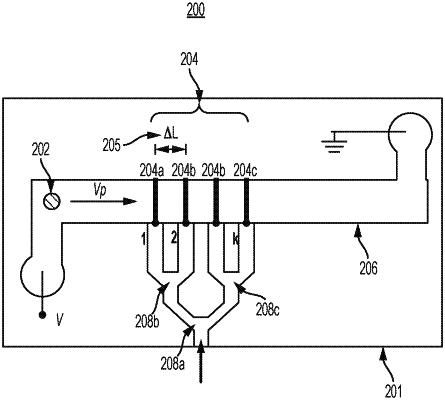| CPC B01L 3/502761 (2013.01) [B01L 3/502715 (2013.01); G01N 15/1434 (2013.01); G01N 15/1459 (2013.01); G01N 15/1484 (2013.01); G01N 27/44726 (2013.01); G01N 27/44773 (2013.01); B01L 2300/0654 (2013.01); B01L 2400/0418 (2013.01); B01L 2400/0421 (2013.01); G01N 2015/1006 (2013.01); G01N 2015/1075 (2013.01); G01N 2015/145 (2013.01); G01N 2015/149 (2013.01)] | 33 Claims |

|
1. A system for identifying a particle based on a velocity of the particle, comprising:
a substrate;
a fluidic channel disposed on the substrate;
a voltage source;
one or more optical components;
one or more optical sensors;
one or more processors; and
a non-transitory computer-readable storage medium storing instructions which, when executed by the one or more processors, cause the system to perform the following:
generating, by the voltage source, an electrical field that induces electrophoretic or electroosmotic flow of a particle labeled with a fluorophore in a mixture through the channel;
illuminating the channel, by the one or more optical components, to form an excitation spot pattern that is incident on the channel, and that optically excites the particle as the particle flows past the excitation spot pattern;
detecting, by the one or more optical sensors, a plurality of signal spikes emitted by the particle in response to the particle being illuminated by the excitation spot pattern, wherein the plurality of signal spikes comprises a first fluorescence signal spike emitted by the particle in response to the particle being illuminated by the excitation spot pattern and a second fluorescence signal spike emitted by the particle in response to the particle being illuminated by the excitation spot pattern;
calculating a velocity of the particle based on the plurality of signal spikes; and
determining an identity of the particle based on the calculated velocity.
|
|
27. A method for identifying a particle based on a velocity of a particle using a planar optofluidic system, the method comprising:
introducing a liquid mixture into a channel of the planar optofluidic system, wherein the mixture comprises a particle labeled with a fluorophore;
generating, by a voltage source of the planar optofluidic system, an electrical field configured to induce electrophoretic or electroosmotic flow of the particle along the channel;
illuminating the channel, by one or more optical components of the planar optofluidic system, to form an excitation spot pattern that is incident on the channel, and that optically excites the particle as the particle flows past an excitation spot pattern, wherein the excitation spot pattern comprises a first excitation spot and a second excitation spot;
detecting, by an optical detector of the planar optofluidic system, a plurality of signal spikes emitted by the particle in response to the particle being illuminated by the excitation spot pattern, wherein the plurality of signal spikes comprises a first fluorescence signal spike emitted by the particle in response to the particle being illuminated by the first excitation spot and a second fluorescence signal spike emitted by the particle in response to the particle being illuminated by the second excitation spot;
calculating, by one or more processors of the planar optofluidic system, based on the plurality of signal spikes, a velocity of the particle; and
determining, by the one or more processors, based on the calculated velocity, an identity of the particle.
|